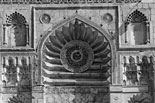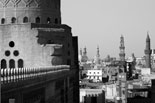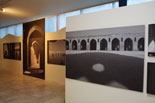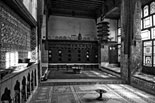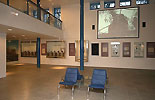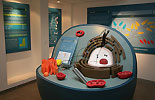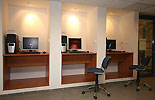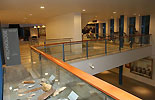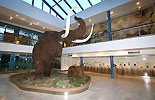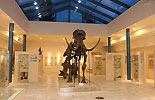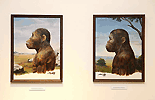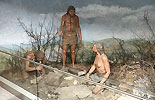THE ANTHROPOS PAVILION
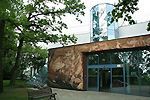 The tradition of our Anthropos Pavilion roots back in the
years of the Republic of Czechoslovakia (1918-1938).
Thanks to the enormous efforts of distinguished Czech researcher
professor PhD. Karel Absolon in 1928 our museum was able to open
an unique exhibition made out of foundings from very earl periods
of human history. The exhibition entitled ANTHROPOS received a great
support from the president T.G. Masaryk and the well-known enterprenour,
Mr. Tomas Bata. During WWII the exhibition was closed. It was professor
dr. Jan Jelinek, internationally recognized anthropologist and museologist
(former director of Moravian Museum and president of ICOM), who folowed
the idea of the founders of ANTHROPOS. In 1962 the newly built Anthropos
Pavilion hosted its first visitors.
The tradition of our Anthropos Pavilion roots back in the
years of the Republic of Czechoslovakia (1918-1938).
Thanks to the enormous efforts of distinguished Czech researcher
professor PhD. Karel Absolon in 1928 our museum was able to open
an unique exhibition made out of foundings from very earl periods
of human history. The exhibition entitled ANTHROPOS received a great
support from the president T.G. Masaryk and the well-known enterprenour,
Mr. Tomas Bata. During WWII the exhibition was closed. It was professor
dr. Jan Jelinek, internationally recognized anthropologist and museologist
(former director of Moravian Museum and president of ICOM), who folowed
the idea of the founders of ANTHROPOS. In 1962 the newly built Anthropos
Pavilion hosted its first visitors.
Address:
Brno, Pisarky Park, The Anthropos Pavilion,
phone: +420-543 212 415, +420-543 248 391


Opening hours,
tickets
Zdeněk Burian: He has seen long bygone worlds...
Picture gallery of Zdeněk Burian from the collections of the Moravian Museum
The Moravian Museum holds in its storerooms the largest collection of Burian's works embracing more than 200 oil
paintings and gouaches complemented with a large number of drawings and sketches. On the occasion of the 30th anniversary
of the artist's death (1905-1981) some of them are presented in a newly open gallery. Fifty representative oil paintings
have been chosen from the immense quantity of Burian's works offering both the insight into the live of prehistorical men
and their predecessors, and the famous reconstructions of animals extinct millions years ago. There is a special publication
accompanying the exhibition.
From May 11, 2011
Cairo - the hidden charm if Islamic architecture
The exhibition has been prepared by the Moravian Museum in co-operation with the Czech Institute
of Egyptology at the Faculty of Arts / Charles University. Black and white photographs of large formate
show the architectural wealth of Cairo, that remains hidden to the common visitor to the Egyptian capital.
The thematically sectioned exhibition shows not only the long story of the urbanistic evolution of the city
but also brings information on types of buildings and their functions; religious and public buildings,
residences and ornaments typical for the embelishment of Islamic architecture are in the centre of interest.
Each building is exactly dated which enables often surprising comparisons of the level of architecture
in Egypt and in the Czech Lands in the given period.
From February 16, 2011 to October 2, 2011
The Anthropos Pavilion / Moravian Museum will be opened to the public after a three year renovation on June 30, 2006.
The building went through a substantial reconstruction and enlargement. Besides the permanent exhibition,
the visitor can find there two halls for short-time exhibitions, a modern conference hall and a café.
The permanent exhibition on the oldest history of the settlement in Moravia as well as on the whole European
continent consists of three parts created by our outstanding specialists: "Moravian Hunters and Gatherers",
"The oldest Art of Europe" (author of the script M. Oliva) and "Palaeolithic Technologies" (authors Z. and P. Neruda).
The second part brings up-to-date discoveries concerning the evolution of man and the beginnings of his culture:
"Genetics in the Evolution of Man" (J. Sekerák), "The Story of Mankind" (Z. Šmahel, M. Dočkalová) complemented
with the presentation of the behaviour of man's next relatives - primates, shown in the section
"Cousins or Brothers? - Ethology of Primates" (V. Vančata). The new permanent exhibition presents up-to date
discoveries from the field of archaeology, anthropology, genetics etc., and proposes interactive presentations
using modern audio-visual techniques; it also contains several dioramas and reconstructions of the environment
and life of Palaeolithic hunters and gatherers. Of course, the visitors will find there the popular
mammoth model surrounded with its natural environment. Financial resources for the reconstruction
of the pavilion and the creation of new exhibitions have been granted by the Ministry of Culture of the Czech Republic.
[Anthropos institute]
Last modified:

|
 The tradition of our Anthropos Pavilion roots back in the
years of the Republic of Czechoslovakia (1918-1938).
Thanks to the enormous efforts of distinguished Czech researcher
professor PhD. Karel Absolon in 1928 our museum was able to open
an unique exhibition made out of foundings from very earl periods
of human history. The exhibition entitled ANTHROPOS received a great
support from the president T.G. Masaryk and the well-known enterprenour,
Mr. Tomas Bata. During WWII the exhibition was closed. It was professor
dr. Jan Jelinek, internationally recognized anthropologist and museologist
(former director of Moravian Museum and president of ICOM), who folowed
the idea of the founders of ANTHROPOS. In 1962 the newly built Anthropos
Pavilion hosted its first visitors.
The tradition of our Anthropos Pavilion roots back in the
years of the Republic of Czechoslovakia (1918-1938).
Thanks to the enormous efforts of distinguished Czech researcher
professor PhD. Karel Absolon in 1928 our museum was able to open
an unique exhibition made out of foundings from very earl periods
of human history. The exhibition entitled ANTHROPOS received a great
support from the president T.G. Masaryk and the well-known enterprenour,
Mr. Tomas Bata. During WWII the exhibition was closed. It was professor
dr. Jan Jelinek, internationally recognized anthropologist and museologist
(former director of Moravian Museum and president of ICOM), who folowed
the idea of the founders of ANTHROPOS. In 1962 the newly built Anthropos
Pavilion hosted its first visitors.

